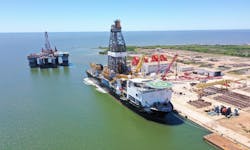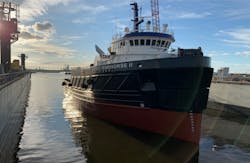ST Engineering upgrades Diamond drillship, Signet tug
Offshore staff
PASCAGOULA, Mississippi – ST Engineering Halter Marine and Offshore has installed a 215-metric ton (237-ton) NOV passive heave compensator on Diamond Offshore’s drillship Ocean BlackLion. The compensator was lifted fully assembled and set on top of the derrick.
The Ocean BlackLion arrived in the deepwater facility in early May. Shipyard cranes were used to support the NOV with all modifications required to suit the new equipment.
The shipyard team installed an MPD piping system and a ballast water treatment system. Both systems were 3D laser scanned and engineered in-house aboard Diamond Offshore vessels during previous projects to avoid interference. Additional shoring of structural support was put in place to accommodate modules.
In addition, the company fabricated miscellaneous platforms, performed upgrades to the ballast water treatment system, relocated the firewater system piping, and painted the exterior hull. It also devised a custom solution for a mechanical tie-in for the ballast water treatment system to avoid disrupting the internal coating systems.
The Ocean BlackLion is the third drillship, and fifth working deep water drilling rig to visit the shipyard under contract to work in the Gulf of Mexico over the last six months.
Also, the company retrofitted new propulsion and maneuvering systems on Signet Maritime Corp.’s Signet Warhouse II.
The scope of work included removing existing shafts and fixed-pitched propellers and replacing with controllable pitch propellers consisting of shaft bearings and shafts. Auxiliary components including the oil distribution box and feedback unit were integrated into the machinery space.
The existing bow tunnel thruster was replaced with a retractable azimuth thruster.
ST Engineering laser scanned the bow hull to create a 3D model so that the hull fairing plates could be developed and installed in way of the new drop-down azimuthing thruster. The installation of the new thruster casing, including the fairing plate and thruster alignment, were executed on a 24-hour shift.
Prior to departure, the vessel was treated to a blast and paint job of underwater/freeboard areas. A complete ABS survey of the hull was conducted upon completion.
08/05/2020

